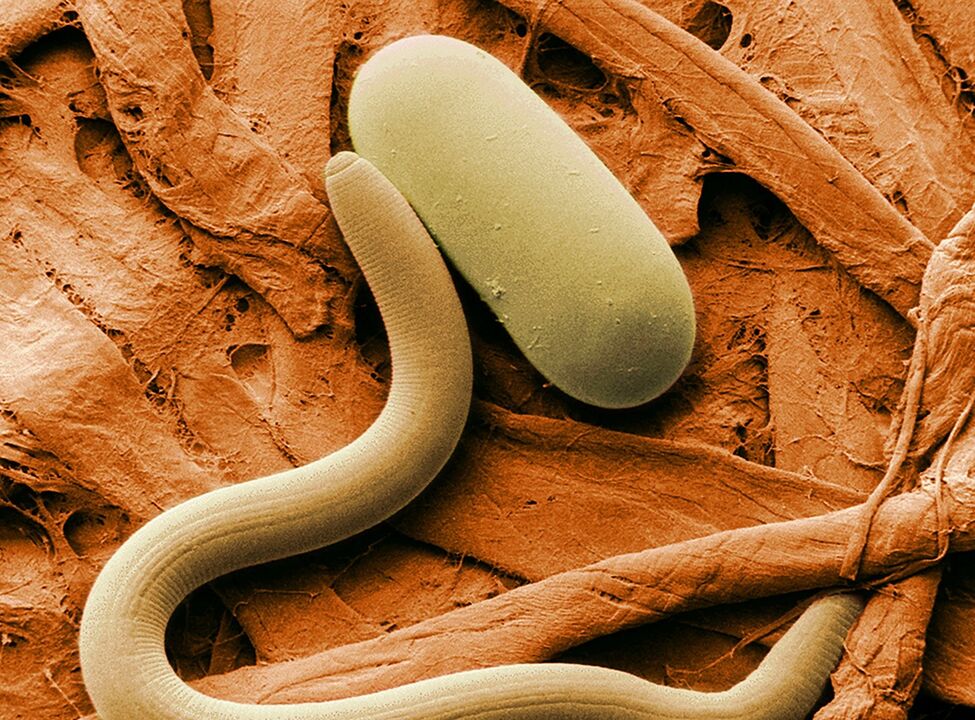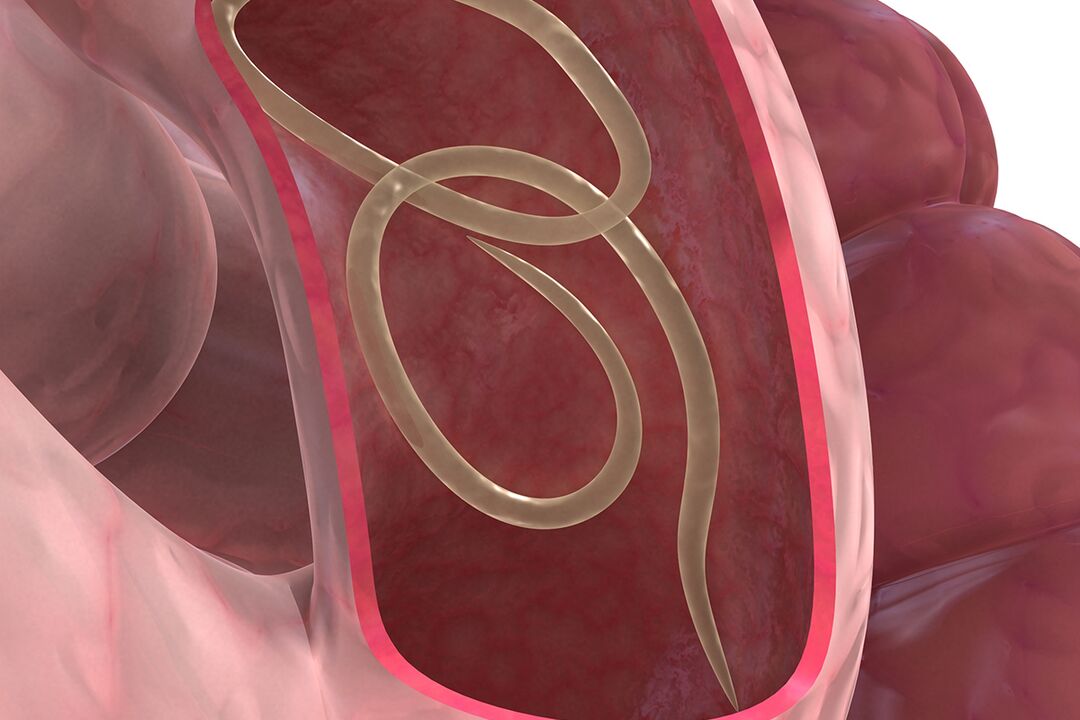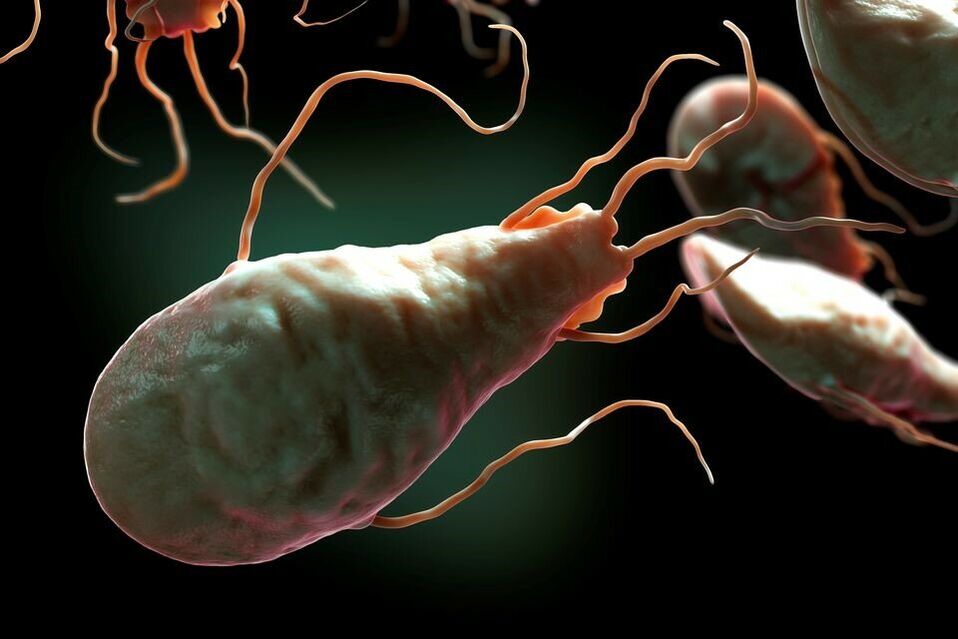Worms are representatives of the lower worms that live in the human body. Diseases associated with people infected with various worms are called helminthiasis. The disease is not uncommon and occurs in certain populations. Children are susceptible to pinworms, hunter-trichinella, fishermen and lovers of Japanese cuisine (raw fish in the form of sushi) suffer from dilobites. Many diseases, paradoxically, can occur in humans as a result of infection with helminthiasis. To date, the theory of the relationship between cancer and parasitic infection is one of the most relevant. In the presence of helminthiasis, symptoms do not always appear, but if a patient with the disease has any unpleasant and uncomfortable feelings, they can be seen as signs of other diseases. The patient had been treated for many years for pancreatitis, gastritis, or colitis, but helminthiasis was not suspected as the cause of his disease.
How the infection happens
Worms cause a lot of trouble for a person

A worm infection occurs as follows:
- by unwashed
- contact with soil
- after insect bites
- because of dirty hands
- When eating raw meat and fish
- After eating unwashed fruits and vegetables
- after contact with animals
- after contact with an infected person
Mature eggs of the parasite can be found in soil, water, food (raw and unheated meat or fish). Rare cases of this disease occur due to insect bites. The infection mechanism of helminthiasis is oral-fecal. A person swallows the eggs of the parasite with food and water. There are also methods of exposure to household infections. They occur after contact with the ground or sand and hands are not washed thoroughly.
Vegetables and berries that grow in the ground without adequate cleaning are also a source of worm infestations. Children who play with yard and pets are at risk of getting worms. Pets that freely roam the streets can bring worm eggs into the house. Insects such as flies can easily spread worm eggs by sitting on food after contact with animal feces. Surprisingly, human-to-human transmission is also possible. Here's how it happens: Female pinworms can crawl out of the intestines and lay their eggs directly on the underwear, causing intense itching. People grooming itchy areas may be exposed to other toiletries and household items. The items fell into the hands of other family members, who then became infected.
It can also be infected through water. Many parasitic eggs easily fall into open bodies of water and wells. Drinking unboiled well water is extremely dangerous.
Types of Helminthosis
Helminthosis enters the body in different ways:
- biological worm
- soil worm
- contagious
Biological worms are transmitted to humans through contact with animals. Soil worms can be infected through the soil. Infectivity arises from contact with an infected person. The disease manifests differently depending on the method of infection, the number of worms, and how well they fit in any human organ.
stages of helminthiasis

The most damaging effects on the body are produced not by the adults but by their larvae. Adult individuals have chosen a comfortable place for themselves within the human body, and the larvae pass through the organs and leave their lesions behind. The most common habitat for parasites is the gastrointestinal tract. Different types of parasites prefer different habitats. So roundworms are located in the small intestine, while pinworms live in the large and lower parts of the small intestine. Depending on the parasite's habitat, helminthiasis are:
- translucent
- fabric
Translucency is located in the lumen of reproductive organs and tissues - the inside of the tissue. Depending on growth, parasites can change their habitat, passing from translucent to tissue forms. Helminthiasis develops in two stages:
- acute
- chronic
The acute phase lasts from one week to a month, and the chronic phase lasts until cured. The acute phase begins with the introduction of eggs and continues as the parasite matures and grows. The disease manifests as an allergic reaction to a foreign organism. During the chronic phase of the disease, the body responds in various ways. During this time, the parasite travels through the body in search of shelter. The disease is accompanied by disturbances in the functioning of the body's organs and systems. After the parasite is integrated into the human immune system, it will consume the substances necessary for its growth and development. This can lead to metabolic disturbances, digestive disturbances, and difficulty absorbing vitamins and minerals.
In addition to this hazard, parasites can also spray their waste into the body, poisoning the body, leading to intestinal diseases, weakened immunity and the development of bacterial infections. Parasites increase the risk of cancer. This is due to negative effects on the immune system and stimulates the process of cell division. Usually, a patient is examined by many specialists who find a bunch of diseases in him. In this case, only one doctor, one parasitologist, can replace all the specialists.
Classification of worms

Roundworms are very common
Types of Human Worms:
- flatworm
- roundworms
Flatworms include:
- Trematodes (opisthorchis, schistosomes, paragonim)
- Tapeworms (Tapeworms, Tapeworms, Echinococcus, Pneumococcus)
- Roundworms or nematodes:
- pinworm
- roundworms
- hookworm
- Trichinella
The classification of this worm is described in the medical literature. A successful solution to a problem like helminthiasis requires an in-depth characterization of the parasite's structure and life cycle.
fluke
Another name for flukes is flukes. These parasites are flat, leaf-like or lanceolate with two suckers. One sucker is in the mouth and the second is used to attach in the peritoneum. All representatives of flukes enter the human body through an intermediate host. Most of these parasites are hermaphrodites.
Opisthorchises
This fluke is a 1. 3 cm long worm with two suction cups. Opisthorchis are hermaphrodites, parasitic in the liver, gallbladder, pancreas of humans and some carnivores (fox, dog, cat). The eggs of opisthorchiasis leave the human or animal body with the feces. When they enter the reservoir, the eggs are swallowed by freshwater mollusks, where the larvae hatch and develop. The process of larval development and maturation lasts two months. The larvae then crawl out of the mollusk and penetrate subcutaneously into the carp. After six weeks, the larvae become mature parasites. Opisthorchis can enter animals or people after eating infected fish. The worm can live in living organisms for up to 20 years. Symptoms of Peyronie's Disease:
- allergy
- weakness
- Headache
- Dizziness
- frustrated
- loss of consciousness
Harmful effects of orchitis on the body:
- parasitic waste poisoning
- liver tissue damage
- gallbladder damage
- Violation of bile outflow
- Pancreatic inflammation
- secretory dysfunction
- Decreased gastric motility
- The walls of some organs thicken and tumors develop.
The chronic course of the disease is characterized by:
- weight after eating
- pain
- Vomit
- nausea
Habitat of opisthorchis in fish-rich rivers:
- turtle
- Dnipro
- Nimman Delta
Prevention of infection: To avoid infection with Toxoplasma gondii, do not eat raw fish. The larvae die during the heat treatment of the product. Only dried fish that has been marinated in advance should be eaten. Also, when the fish is frozen for a long time, the larvae die.
Schistosoma

These parasites have different sexes, they look like a needle 0. 4 to 2. 6 centimeters long, females are longer than males, larger in size, and lay 3, 000 eggs per day. As with previous parasite species, the method of reproduction is through freshwater mollusks. The larvae enter the human body through the skin and mucous membranes while swimming in freshwater reservoirs. It can also enter the body of someone who accidentally swallows water while swimming. One day after penetration, the larvae become adults and enter peripheral veins through which they enter the lungs and venous vessels. There, schistosomes reach sexual maturity.
Schistosomiasis lay eggs in the gut, mucous membranes, and bladder. The eggs are then expelled from the body in urine or faeces, where the developmental path resumes. Schistosoma worms live in the human body for decades, causing damage and infecting new individuals. In the process of infection with schistosomiasis, the human body is not more of adults, but their eggs. Only half of the eggs are released from the body, and the rest accumulate in the organs. The parasite's eggs have spikes that can damage a person's internal organs, and ulcers usually develop in those infected. People with schistosomiasis experience the following symptoms:
- loss of appetite
- anemia
- enlarged liver
- spleen changes
- decreased bowel motility
- stomach ache
- constipate
- diarrhea
- lose weight
- intestinal bleeding
- pain when urinating
- allergy
- weakness
When the genitourinary system is infected, patients experience:
- Irregular menstruation and miscarriage in women
- Male impotence and ejaculation insufficiency
When eggs enter the central nervous system:
- acute cerebral schistosomiasis
- chronic brain injury
- fatal result
Infected children experience delayed growth and reduced academic performance. Prevention of illness includes avoiding swimming and avoiding walking barefoot in tropical waters.
model

Paragonim is a 1 cm long paragonimus with an ovoid body and red spines. The parasite reproduces in the lungs of animals and enters humans by eating crayfish and freshwater crabs. Parasites infect the respiratory system. In patients with paragonimiasis, allergic reactions and decreased immunity are characteristic. symptom:
- temperature rise
- cough
- expel phlegm from the lungs when coughing
- Difficulty breathing
- In severe cases, blood and parasite eggs are present in the sputum.
- A wheezing sound can be clearly heard in the patient's lungs.
- Prevention: Exclude the use of raw crayfish and crabs.
tapeworm
Tapeworms are represented by tapeworms of various lengths. Some parasites reach enormous sizes. These parasites have suckers, hooks, or suction mouths on their heads. These adaptations are necessary for the parasite to adhere to the intestinal wall. Tapeworms affect the entire body, and they are most dangerous to children who rapidly develop anemia.
Echinococcus
These parasites grow to 5 cm and are the causative agent of echinococcosis. The multi-chambered representation of this worm is the causative agent of diseases such as pulmonary alveococcosis. The disease is carried by cattle and livestock. While caring for these animals, parasite eggs fall from their fur into people's hands. When entering the human gut, the parasite bites into the mucous membranes. As the parasite matures, 4 sections will appear, with the last section stuffed with eggs. These divisions shed and spread all over the body, infecting it. The fourth part spreads the eggs all over the body.
Infected organs such as the liver increase in patients. Suppository formation may occur. An enlarged organ can even break through the abdominal cavity. This can lead to severe sepsis in the body and even death. symptom:
- weakness
- Dizziness
- Allergic reaction to parasite waste.
Echinococcus effects:
- brain
- spinal cord
- Eye
- thyroid
- liver
- lung
- Uterus
This parasite can cause tumor formation, including malignant tumors. The most unpleasant thing is that the treatment of this disease can only be done by surgery. Prevention: Personal hygiene in contact with animals.
nematodes
These worms with elongated bodies, round or cylindrical form are most commonly parasitic in children. These roundworms include pinworms, roundworms, and hookworms.
pinworm

These are small white worms. Females are 1 cm long and males are 0. 5 cm long. These parasites have a pointed tail, so they are called pinworms. The habitat of pinworms is the human gut. The front end of the parasite has a sucker, with the help of which the pinworm burrows into the intestine, the tip drooping into the lumen and damaging the wall. This disease is called enterobiasis. You can infect others with dirty hands. Preschoolers who go to kindergarten have a disease. One symptom of pinworm infection is itching around the anus. More commonly, itching occurs during the night when the female lays eggs and releases a special substance. symptom:
- itching
- diarrhea
- stomach ache
- Headache
- loss of appetite
- prevention
- handwashing
roundworms
These worms are the largest. The female is 0. 5m long, and the female lays 200, 000 eggs a year, regardless of the male. The mechanism of infection is fecal-oral. Ascaris eggs enter the body through dirty hands along with unwashed vegetables and fruits. The larvae that have entered the gut are picked out of the shell and penetrate the gut wall while migrating to the liver through the intestinal vein, to the heart through the hepatic vein, to the bronchi through the pulmonary artery, and then into the bronchi. trachea and into the mouth. Some of the larvae die in the open, while the rest are swallowed backwards. symptom:
- nausea
- Vomit
- jaundice
- pancreatitis
- frequent acute respiratory infections
- bronchitis
- pneumonia
prevention:
- handwashing
- Wash vegetables and fruits
- personal hygiene
- Protect food from flies, cockroaches and other vendors.
In conclusion, we can say that the cause of disease is not always bacteria and viruses that enter the body. Parasites can cause great harm to human health. In the case of ambiguous symptoms, it is not necessary to exclude parasites from entering the body, and the patient should see a parasitologist.



























